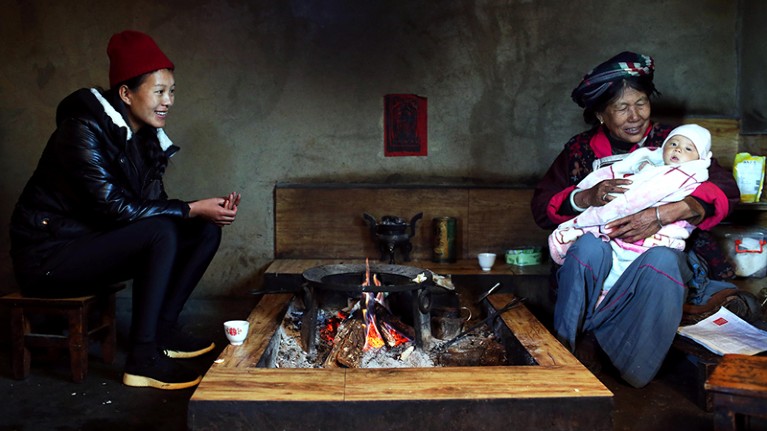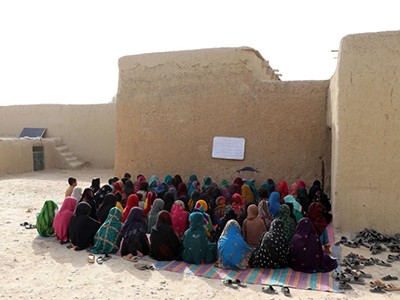
The Mosuo people of China include sub-communities in which inheritance passes down either the male or the female line.Credit: TPG/Getty
The fight for global gender equality is nowhere close to being won. Take education: in 87 countries, less than half of women and girls complete secondary schooling, according to 2023 data. Afghanistan’s Taliban continues to ban women and girls from secondary schools and universities. Or take reproductive health: abortion rights have been curtailed in 22 US states since the Supreme Court struck down federal protections, depriving women and girls of autonomy and restricting access to sexual and reproductive health care.
SDG 5, whose stated aim is to “achieve gender equality and empower all women and girls”, is the fifth of the 17 United Nations Sustainable Development Goals, all of which Nature is examining in a series of editorials. SDG 5 includes targets for ending discrimination and violence against women and girls in both public and private spheres, eradicating child marriage and female genital mutilation, ensuring sexual and reproductive rights, achieving equal representation of women in leadership positions and granting equal rights to economic resources. Globally, the goal is not on track to being achieved, and just a handful of countries have hit all the targets.
How the world should oppose the Taliban’s war on women and girls
In July, the UN introduced two new indices (see go.nature.com/3eus9ue), the Women’s Empowerment Index (WEI) and the Global Gender Parity Index (GGPI). The WEI measures women’s ability and freedoms to make their own choices; the GGPI describes the gap between women and men in areas such as health, education, inclusion and decision making. The indices reveal, depressingly, that even achieving a small gender gap does not automatically translate to high levels of women’s empowerment: 114 countries feature in both indices, but countries that do well on both scores cover fewer than 1% of all girls and women.
The COVID-19 pandemic has made things worse, with women bearing the highest burden of extra unpaid childcare when schools needed to close, and subjected to intensified domestic violence. Although child marriages declined from 21% of all marriages in 2016 to 19% in 2022, the pandemic threatened even this incremental progress, pushing up to 10 million more girls into risk of child marriage over the next decade, in addition to the 100 million girls who were at risk before the pandemic.
Of the 14 indicators for SDG 5, only one or two are close to being met by the 2030 deadline. As of 1 January 2023, women occupied 35.4% of seats in local-government assemblies, an increase from 33.9% in 2020 (the target is gender parity by 2030). In 115 countries for which data were available, around three-quarters, on average, of the necessary laws guaranteeing full and equal access to sexual and reproductive health and rights had been enacted. But the UN estimates that worldwide, only 57% of women who are married or in a union make their own decisions regarding sexual and reproductive health and rights.
Systemic discrimination against girls and women by men, in many contexts, remains a colossal barrier to achieving gender equality. But patriarchy is not some “natural order of things”, argues Ruth Mace, an anthropologist at University College London. Hundreds of women-centred societies exist around the world. As the science writer Angela Saini describes in her latest book, The Patriarchs, these are often not the polar opposite of male-dominated systems, but societies in which men and women share decision making.
After Roe v. Wade: dwindling US abortion access is harming health a year later
One example comes from the Mosuo people in China, who have both ‘matrilineal’ and ‘patrilineal’ communities, with rights such as inheritance passing down either the male or female line. Researchers compared outcomes for inflammation and hypertension in men and women in these communities, and found that women in matrilineal societies, in which they have greater autonomy and control over resources, experienced better health outcomes. The researchers found no significant negative effect of matriliny on health outcomes for men (A. Z. Reynolds et al. Proc. Natl Acad. Sci. USA 117, 30324–30327; 2020).
When it comes to the SDGs, evidence is emerging that a more gender-equal approach to politics and power benefits many goals. In a study published in May, Nobue Amanuma, deputy director of the Integrated Sustainability Centre at the Institute for Global Environmental Strategies in Hayama, Japan, and two of her colleagues tested whether countries with more women legislators, and more younger legislators, are performing better in the SDGs (N. Amanuma et al. Environ. Res. Lett. 18, 054018; 2023). They found it was so, with the effect more marked for socio-economic goals such as ending poverty and hunger, than for environmental ones such as climate action or preserving life on land. The researchers recommend further qualitative and quantitative studies to better understand the reasons.
The reality that gender equality leads to better outcomes across other SDGs is not factored, however, into most of the goals themselves. Of the 230 unique indicators of the SDGs, 51 explicitly reference women, girls, gender or sex, including the 14 indicators in SDG 5. But there is not enough collaboration between organizations responsible for the different SDGs to ensure that sex and gender are taken into account. The indicator for the sanitation target (SDG 6) does not include data disaggregated by sex or gender (Nature 620, 7; 2023). Unless we have this knowledge, it will be hard to track improvements in this and other SDGs.
The road to a gender-equal world is long, and women’s power and freedom to make choices is still very constrained. But the evidence from science is getting stronger: distributing power between genders creates the kind of world we all need and want to be living in.

 Progress towards the Sustainable Development Goals
Progress towards the Sustainable Development Goals
 How the world should oppose the Taliban’s war on women and girls
How the world should oppose the Taliban’s war on women and girls
 After Roe v. Wade: dwindling US abortion access is harming health a year later
After Roe v. Wade: dwindling US abortion access is harming health a year later
 Women are most affected by pandemics — lessons from past outbreaks
Women are most affected by pandemics — lessons from past outbreaks
 Sex and gender analysis improves science and engineering
Sex and gender analysis improves science and engineering




